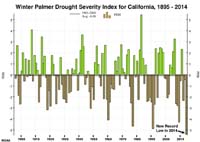8.10: Weather and Climates
- Page ID
- 10271
\( \newcommand{\vecs}[1]{\overset { \scriptstyle \rightharpoonup} {\mathbf{#1}} } \)
\( \newcommand{\vecd}[1]{\overset{-\!-\!\rightharpoonup}{\vphantom{a}\smash {#1}}} \)
\( \newcommand{\dsum}{\displaystyle\sum\limits} \)
\( \newcommand{\dint}{\displaystyle\int\limits} \)
\( \newcommand{\dlim}{\displaystyle\lim\limits} \)
\( \newcommand{\id}{\mathrm{id}}\) \( \newcommand{\Span}{\mathrm{span}}\)
( \newcommand{\kernel}{\mathrm{null}\,}\) \( \newcommand{\range}{\mathrm{range}\,}\)
\( \newcommand{\RealPart}{\mathrm{Re}}\) \( \newcommand{\ImaginaryPart}{\mathrm{Im}}\)
\( \newcommand{\Argument}{\mathrm{Arg}}\) \( \newcommand{\norm}[1]{\| #1 \|}\)
\( \newcommand{\inner}[2]{\langle #1, #2 \rangle}\)
\( \newcommand{\Span}{\mathrm{span}}\)
\( \newcommand{\id}{\mathrm{id}}\)
\( \newcommand{\Span}{\mathrm{span}}\)
\( \newcommand{\kernel}{\mathrm{null}\,}\)
\( \newcommand{\range}{\mathrm{range}\,}\)
\( \newcommand{\RealPart}{\mathrm{Re}}\)
\( \newcommand{\ImaginaryPart}{\mathrm{Im}}\)
\( \newcommand{\Argument}{\mathrm{Arg}}\)
\( \newcommand{\norm}[1]{\| #1 \|}\)
\( \newcommand{\inner}[2]{\langle #1, #2 \rangle}\)
\( \newcommand{\Span}{\mathrm{span}}\) \( \newcommand{\AA}{\unicode[.8,0]{x212B}}\)
\( \newcommand{\vectorA}[1]{\vec{#1}} % arrow\)
\( \newcommand{\vectorAt}[1]{\vec{\text{#1}}} % arrow\)
\( \newcommand{\vectorB}[1]{\overset { \scriptstyle \rightharpoonup} {\mathbf{#1}} } \)
\( \newcommand{\vectorC}[1]{\textbf{#1}} \)
\( \newcommand{\vectorD}[1]{\overrightarrow{#1}} \)
\( \newcommand{\vectorDt}[1]{\overrightarrow{\text{#1}}} \)
\( \newcommand{\vectE}[1]{\overset{-\!-\!\rightharpoonup}{\vphantom{a}\smash{\mathbf {#1}}}} \)
\( \newcommand{\vecs}[1]{\overset { \scriptstyle \rightharpoonup} {\mathbf{#1}} } \)
\( \newcommand{\vecd}[1]{\overset{-\!-\!\rightharpoonup}{\vphantom{a}\smash {#1}}} \)
\(\newcommand{\avec}{\mathbf a}\) \(\newcommand{\bvec}{\mathbf b}\) \(\newcommand{\cvec}{\mathbf c}\) \(\newcommand{\dvec}{\mathbf d}\) \(\newcommand{\dtil}{\widetilde{\mathbf d}}\) \(\newcommand{\evec}{\mathbf e}\) \(\newcommand{\fvec}{\mathbf f}\) \(\newcommand{\nvec}{\mathbf n}\) \(\newcommand{\pvec}{\mathbf p}\) \(\newcommand{\qvec}{\mathbf q}\) \(\newcommand{\svec}{\mathbf s}\) \(\newcommand{\tvec}{\mathbf t}\) \(\newcommand{\uvec}{\mathbf u}\) \(\newcommand{\vvec}{\mathbf v}\) \(\newcommand{\wvec}{\mathbf w}\) \(\newcommand{\xvec}{\mathbf x}\) \(\newcommand{\yvec}{\mathbf y}\) \(\newcommand{\zvec}{\mathbf z}\) \(\newcommand{\rvec}{\mathbf r}\) \(\newcommand{\mvec}{\mathbf m}\) \(\newcommand{\zerovec}{\mathbf 0}\) \(\newcommand{\onevec}{\mathbf 1}\) \(\newcommand{\real}{\mathbb R}\) \(\newcommand{\twovec}[2]{\left[\begin{array}{r}#1 \\ #2 \end{array}\right]}\) \(\newcommand{\ctwovec}[2]{\left[\begin{array}{c}#1 \\ #2 \end{array}\right]}\) \(\newcommand{\threevec}[3]{\left[\begin{array}{r}#1 \\ #2 \\ #3 \end{array}\right]}\) \(\newcommand{\cthreevec}[3]{\left[\begin{array}{c}#1 \\ #2 \\ #3 \end{array}\right]}\) \(\newcommand{\fourvec}[4]{\left[\begin{array}{r}#1 \\ #2 \\ #3 \\ #4 \end{array}\right]}\) \(\newcommand{\cfourvec}[4]{\left[\begin{array}{c}#1 \\ #2 \\ #3 \\ #4 \end{array}\right]}\) \(\newcommand{\fivevec}[5]{\left[\begin{array}{r}#1 \\ #2 \\ #3 \\ #4 \\ #5 \\ \end{array}\right]}\) \(\newcommand{\cfivevec}[5]{\left[\begin{array}{c}#1 \\ #2 \\ #3 \\ #4 \\ #5 \\ \end{array}\right]}\) \(\newcommand{\mattwo}[4]{\left[\begin{array}{rr}#1 \amp #2 \\ #3 \amp #4 \\ \end{array}\right]}\) \(\newcommand{\laspan}[1]{\text{Span}\{#1\}}\) \(\newcommand{\bcal}{\cal B}\) \(\newcommand{\ccal}{\cal C}\) \(\newcommand{\scal}{\cal S}\) \(\newcommand{\wcal}{\cal W}\) \(\newcommand{\ecal}{\cal E}\) \(\newcommand{\coords}[2]{\left\{#1\right\}_{#2}}\) \(\newcommand{\gray}[1]{\color{gray}{#1}}\) \(\newcommand{\lgray}[1]{\color{lightgray}{#1}}\) \(\newcommand{\rank}{\operatorname{rank}}\) \(\newcommand{\row}{\text{Row}}\) \(\newcommand{\col}{\text{Col}}\) \(\renewcommand{\row}{\text{Row}}\) \(\newcommand{\nul}{\text{Nul}}\) \(\newcommand{\var}{\text{Var}}\) \(\newcommand{\corr}{\text{corr}}\) \(\newcommand{\len}[1]{\left|#1\right|}\) \(\newcommand{\bbar}{\overline{\bvec}}\) \(\newcommand{\bhat}{\widehat{\bvec}}\) \(\newcommand{\bperp}{\bvec^\perp}\) \(\newcommand{\xhat}{\widehat{\xvec}}\) \(\newcommand{\vhat}{\widehat{\vvec}}\) \(\newcommand{\uhat}{\widehat{\uvec}}\) \(\newcommand{\what}{\widehat{\wvec}}\) \(\newcommand{\Sighat}{\widehat{\Sigma}}\) \(\newcommand{\lt}{<}\) \(\newcommand{\gt}{>}\) \(\newcommand{\amp}{&}\) \(\definecolor{fillinmathshade}{gray}{0.9}\)Weather and Climates
Weather is localized atmospheric conditions in the short term (described in terms of minute, hours, or possibly weeks).
Climate is the prevailing weather conditions in an area in general or over a long period (years, decades, etc.).
Weather is typically constantly changing as air masses move across a region. A most common question on a long-distance phone call is: "How is the weather out there?" The answer can typically be "it's sunny," "it's cold," "it's snowing," "or "it's raining cats and dogs," or any other description of the prevailing atmospheric at any time in a location.
Climates are controlled by both geographic factors and regional weather patterns. Different regions (climates) typically have seasonal cycles. For instance, the Eastern United States typically has 4 seasons and have frequent weather fronts between polar air masses from Canada and tropical air masses from the Gulf and Atlantic regions. In contrast, California typically has 2 seasons, summers are dry and winters have short rainy periods. Patterns in weather repeat each year and are typically consistent and predictable with seasons of the year. Examples include monsoons in India and the US Desert Southwest, Hurricane season in the tropics, etc. Figure 8.25 illustrates how California's weather and climate is influenced by regional geography and prevailing weather conditions.
History shows that climates change. The time spans for changes can range in cycles ranging from years and decades to centuries, or thousands of years. Droughts can start an last for years. Desertification (such as what is happening in Africa) has been progressing for centuries. Parts of the world experienced Mini-Ice Age conditions between the 13th and 19th centuries. Climate change has impacted civilizations throughout recorded history. A classic example is illustrated in the history of the Chaco Culture in the US Desert Southwest (Figure 8.26). See more climate cycle times and events in history on NOAA's Paleoclimatology website).
See NOAA's Climate Change Impacts website - time lines with many links and animations.
Climate Variability
California's history of droughts illustrates climate variability (Figure 8.27). Climate not only vary on a seasonal and annual basis, but there are larger scale fluctuations that impact different regions of the world. One is the El Niño/Southern Oscillation (ENSO) (discussed in Chapter 9). Because the atmosphere is an open system, changes in one region can affect other surrounding regions. Regions that may experience dry conditions for decades may suddenly have a severe rain period, or regions that are typically wet can sustain drought. Likewise, regional temperature average can swing through cyclic periods. Some of these changes can be progressive and represent long term changes. For instance, during the last ice age, Southern California was very wet, and large lakes filled many of the basins between mountain ranges. By about 5,000 years ago, the lakes dried up as the climate changed, then they returned as wet conditions returned for periods of time. The last major drying period was about 500 years ago, as recorded by the evidence of Indian village sites associated with fishing on the shores of SoCal lakes that now are mostly barren desert. See a website on Climate Variability (NASA).

Figure 8.27. California's cycles of drought and wet periods is an example of climate variability.
Effects Of Uneven Heating Of Earth By the Sun
The amount of energy Earth receives from the Sun is not evenly distributed (Figure 8.28). More solar energy (per unit area) is delivered to the equator than near the poles.
• The equatorial regions are warmer than the poles because direct sunlight is concentrated and little is reflected.
• In polar regions, light strikes the earth at an angle; it is diffuse and much of it is reflected back into space.
• The seasonal variations (winter and summer) also affect the distribution of heating of the planet.
This imbalance between the solar heating in the tropics and at the polar regions is a major factor in atmospheric movement on Earth and other planets with atmospheres.





